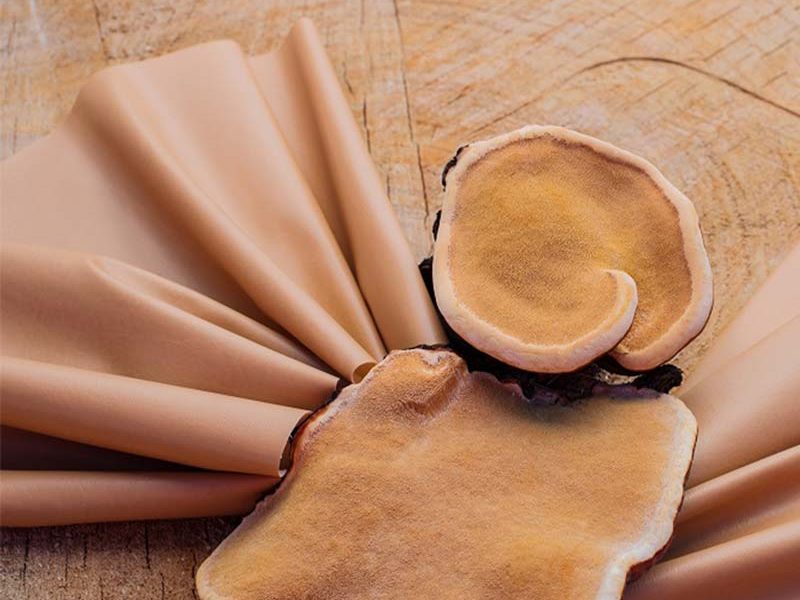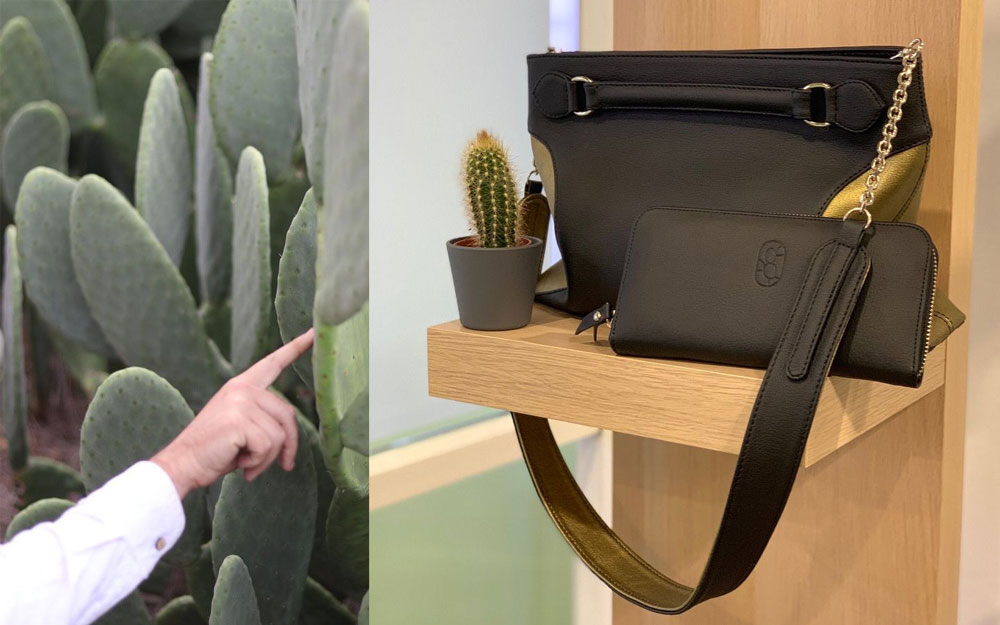
Als Veganerin und Verfechterin nachhaltiger Mode bin ich unglaublich gespannt auf die zukünftige Entwicklung von pflanzlichem Leder. Dieses innovative Material bietet eine tierversuchsfreie und umweltfreundliche Alternative zu traditionellem Tierleder und ich glaube, dass es das Potenzial hat, die Modebranche zu revolutionieren.
Ein weiterer Wachstumsbereich für pflanzliches Leder ist der Luxusmarkt. Während vegane Mode traditionell mit minderwertiger und minderwertiger Kleidung in Verbindung gebracht wird, erweist sich pflanzliches Leder als vielseitiges und hochwertiges Material, aus dem sich schöne und modische Kleidungsstücke herstellen lassen. Da immer mehr Designer und Modehäuser pflanzliches Leder in ihre Kollektionen integrieren, wird es immer beliebter und zum Mainstream werden.
Heute werde ich Ihnen eine detaillierte Einführung in dieses natürliche und umweltfreundliche Leder auf Pflanzenbasis geben.
Pflanzliches Leder ist eine Materialart, die aus pflanzlichen Materialien und nicht aus Tierhäuten hergestellt wird. Es wird oft als tierversuchsfreie und umweltfreundliche Alternative zu herkömmlichem Leder verwendet. Pflanzliches Leder kann aus einer Vielzahl pflanzlicher Materialien wie Kork, Rinde und sogar Pilzen hergestellt werden. Der spezifische Prozess zur Herstellung von Leder auf Pflanzenbasis variiert je nach Art des verwendeten Pflanzenmaterials. Typischerweise umfasst er jedoch die Zerkleinerung der Pflanzenfasern und deren anschließende Kombination mit einem Bindemittel, um ein Material zu erzeugen, das in Aussehen und Textur tierischen ähnelt Leder.
Einer der Hauptvorteile von pflanzlichem Leder ist seine Umweltfreundlichkeit. Die Herstellung von Tierleder ist eine äußerst umweltschädliche Industrie, da beim Gerben häufig giftige Chemikalien wie Chrom und Formaldehyd verwendet werden. Diese Chemikalien können Boden und Wasser verunreinigen und negative Auswirkungen auf die Umwelt und die menschliche Gesundheit haben. Im Gegensatz dazu werden bei der Herstellung von pflanzlichem Leder weniger giftige Chemikalien eingesetzt und es entsteht weniger Abfall. Darüber hinaus gelten einige pflanzliche Materialien, die zur Herstellung von pflanzlichem Leder verwendet werden, wie etwa Kork- und Ananasblätter, als Abfallprodukte aus anderen Industrien und würden andernfalls entsorgt. Durch die Wiederverwendung dieser Materialien trägt die pflanzliche Lederproduktion dazu bei, Abfall zu reduzieren und Ressourcen zu schonen.

Ein weiterer Vorteil von pflanzlichem Leder ist seine Haltbarkeit. Viele Menschen stehen der Haltbarkeit von pflanzlichem Leder skeptisch gegenüber und glauben, dass es nicht so stark und langlebig ist wie tierisches Leder. Dies ist jedoch nicht der Fall. Tatsächlich kann pflanzliches Leder genauso langlebig sein wie tierisches Leder, bei manchen Arten sogar noch haltbarer. Korkleder ist beispielsweise extrem wasser- und kratzfest und eignet sich daher hervorragend für Schuhe und Taschen, die den Elementen ausgesetzt sind. Darüber hinaus kann pflanzliches Leder mit Schutzbeschichtungen behandelt werden, um seine Haltbarkeit und Langlebigkeit weiter zu verbessern.
Zusätzlich zu seinen Umwelt- und Haltbarkeitsvorteilen ist pflanzliches Leder auch eine humanere Option als tierisches Leder. Bei der Herstellung von Tierleder kommt es häufig zu unmenschlicher Behandlung der Tiere, einschließlich Enthornen, Brandmarkieren und Kupieren des Schwanzes. Darüber hinaus werden viele Tiere, die zur Lederherstellung verwendet werden, unter beengten und unhygienischen Bedingungen gehalten, was zu erheblichem Tierleid führt. Im Gegensatz dazu erfordert die Herstellung von pflanzlichem Leder weder die Tötung noch die Misshandlung von Tieren. Durch die Wahl von pflanzlichem Leder können Verbraucher eine mitfühlendere und ethischere Industrie unterstützen.

Trotz seiner vielen Vorteile ist pflanzliches Leder nicht ohne Nachteile. Eine der größten Herausforderungen bei pflanzlichem Leder sind seine Kosten. Im Allgemeinen ist pflanzliches Leder aufgrund der hohen Kosten pflanzlicher Materialien und des arbeitsintensiven Produktionsprozesses teurer als tierisches Leder. Dies kann es für Verbraucher schwierig machen, den höheren Preis zu rechtfertigen, insbesondere wenn günstigere Optionen aus Tierleder leicht verfügbar sind.
Eine weitere Herausforderung von pflanzlichem Leder ist seine Verfügbarkeit. Im Gegensatz zu Tierleder, das in großem Umfang hergestellt und verkauft wird, ist pflanzliches Leder immer noch ein relativer Nischenmarkt. Infolgedessen könnte es für Verbraucher schwierig sein, in den gängigen Geschäften ein breites Sortiment an pflanzlichen Lederprodukten wie Schuhen und Kleidung zu finden. Dies kann es für Verbraucher schwierig machen, pflanzliches Leder vollständig in ihre Garderobe zu integrieren, was seine potenziellen Auswirkungen auf den Markt begrenzt.
Trotz dieser Herausforderungen glaube ich, dass pflanzliches Leder eine wertvolle und wichtige Alternative zu herkömmlichem Tierleder ist. Seine ökologischen, langlebigen und humanen Vorteile machen es zu einer überzeugenden Wahl für diejenigen, die ihre Auswirkungen auf den Planeten reduzieren und ethischere Praktiken unterstützen möchten. Da das Bewusstsein für diese Probleme wächst, hoffe ich auf eine Verschiebung hin zu einer stärkeren Akzeptanz von pflanzlichem Leder, was zu einer nachhaltigeren und mitfühlenderen Modebranche führen wird.
Kork ist eine nachhaltige, erneuerbare Ressource, die von Bäumen geerntet werden kann, ohne diese zu beschädigen. Anschließend wird es zu einem Material verarbeitet, das Leder ähnelt und zur Herstellung einer Vielzahl von Produkten wie Taschen, Schuhen und Accessoires verwendet werden kann.
Ananasleder, auch „Ananasblattfaser“ oder „Piñatex“ genannt, wird aus den Blättern der Ananaspflanze hergestellt. Die Blätter werden geerntet, getrocknet und dann zu einem Material verarbeitet, das in Aussehen und Textur Leder ähnelt. Ananasleder ist langlebig, flexibel und nachhaltig und daher eine beliebte Wahl für eine Vielzahl von Produkten.

Pilzleder, auch „Pilzleder“ genannt, wird aus den Stielen von Pilzen hergestellt. Die Stängel werden zu einem Material verarbeitet, das eine lederähnliche Optik und Haptik aufweist und zur Herstellung verschiedener Produkte wie Schuhe, Taschen und Accessoires verwendet werden kann.

Maisleder wird aus den Fasern von Maisstängeln hergestellt, die zu einem lederähnlichen Material verarbeitet werden. Es ist eine nachhaltige und umweltfreundliche Alternative zu herkömmlichem Leder und kann zur Herstellung einer Vielzahl von Produkten wie Schuhen, Taschen und Accessoires verwendet werden.

Kokosleder wird aus den Fasern der Kokosnussschale hergestellt, die zu einem lederähnlichen Material verarbeitet werden. Es ist eine nachhaltige und langlebige Alternative zu herkömmlichem Leder und kann zur Herstellung einer Reihe von Produkten wie Schuhen, Taschen und Accessoires verwendet werden.

Kaktusleder ist eine Art pflanzliches Leder, das aus den Fasern der Kaktuspflanze hergestellt wird. Es gilt als nachhaltige und umweltfreundliche Alternative zu herkömmlichem Tierleder, da es tierschonend hergestellt werden kann und bei der Herstellung weniger Wasser und andere Ressourcen benötigt werden. Kaktusleder ist außerdem langlebig und flexibel, was es zu einem guten Material für den Einsatz in einer Vielzahl von Anwendungen macht.

Als jemand, der Wert auf Nachhaltigkeit und ethischen Konsum legt, habe ich mich schon immer zu Leder auf pflanzlicher Basis gegenüber tierischem Leder hingezogen gefühlt. Hier sind einige der wichtigsten Unterschiede zwischen den beiden:
Nachhaltigkeit: Pflanzliche Leder sind viel nachhaltiger als tierische Leder. Sie werden aus nachwachsenden Rohstoffen wie Kork oder Pilzen hergestellt und benötigen nicht die gleichen Mengen an Ressourcen wie Wasser und Land wie Tierleder.
Ethik: Bei Leder auf pflanzlicher Basis werden im Gegensatz zu Tierleder keine Tiere ausgebeutet. Bei der Herstellung von Tierleder sind häufig grausame Praktiken wie Enthornen und Brandmarkieren erforderlich, die für die Herstellung von Leder auf pflanzlicher Basis nicht erforderlich sind.
Kosten: Pflanzliche Leder sind oft günstiger als tierische Leder. Dies liegt daran, dass sie nicht den gleichen Ressourcen- und Arbeitsaufwand erfordern und nicht den gleichen Marktschwankungen unterliegen wie Tierleder.
Haltbarkeit: Pflanzliche Leder sind oft genauso langlebig wie tierische Leder, wenn nicht sogar noch langlebiger. Sie sind resistent gegen Wasser, Flecken und andere Umwelteinflüsse und erfordern nicht das gleiche Maß an Pflege und Wartung wie Tierleder.
Aussehen: Pflanzliches Leder kann genauso schön und stilvoll sein wie tierisches Leder. Sie sind in einer Vielzahl von Farben und Texturen erhältlich und können so gestaltet werden, dass sie das Aussehen von Tierleder nachahmen.
Kompfort: Pflanzliche Leder sind oft angenehmer zu tragen als tierische Leder. Sie sind atmungsaktiv, leicht und speichern keine Wärme, was sie ideal für den Einsatz in Schuhen, Taschen und anderen Accessoires macht.
Vielseitigkeit: Leder auf pflanzlicher Basis können in einer Vielzahl von Anwendungen eingesetzt werden, von der Mode bis hin zu Möbeln. Sie sind vielseitig einsetzbar und können in verschiedenen Formen und Größen geformt werden, sodass sie für eine Vielzahl von Produkten geeignet sind.
Umweltbelastung: Pflanzliche Leder haben eine viel geringere Umweltbelastung als tierische Leder. Sie benötigen nicht so viel Land, Wasser und Energie und tragen nicht in der gleichen Weise zu Umweltverschmutzung und Abfall bei wie Tierleder.
Gesundheit: Leder auf pflanzlicher Basis ist oft gesünder für den Benutzer und die Umwelt als tierisches Leder. Sie sind hypoallergen und enthalten keine Chemikalien wie Chrom, die häufig bei der Herstellung von Tierleder verwendet werden.
Leistung: Leder auf pflanzlicher Basis übertrifft tierisches Leder oft in Bezug auf Haltbarkeit, Komfort und Stil. Sie sind oft flexibler und atmungsaktiver und erfordern nicht den gleichen Pflege- und Wartungsaufwand wie Tierleder.
Insgesamt glaube ich, dass pflanzliches Leder für diejenigen, die Wert auf Nachhaltigkeit, Ethik und Leistung legen, eine bessere Wahl als tierisches Leder ist. Sie sind nachhaltiger, erschwinglicher und vielseitiger und beinhalten keine Ausbeutung von Tieren. Sie haben außerdem eine geringere Umweltbelastung und sind sowohl für den Benutzer als auch für die Umwelt gesünder.
Zu den Luxusmarken, die in ihren Produkten Leder auf pflanzlicher Basis verwenden, gehören:
Stella McCartney – verwendet eine pflanzliche Lederalternative namens „Alter-Nappa” in ihren Taschen und Schuhen.
Gucci – verwendet eine pflanzliche Lederalternative namens „Ökologisch pflanzlich gegerbtes Leder” in ihren Taschen und Accessoires.
Hermes – verwendet in seinen Taschen und Accessoires eine Lederalternative auf pflanzlicher Basis namens „Veau Trade“.
Tod’s – verwendet in seinen Taschen und Schuhen eine Lederalternative auf pflanzlicher Basis namens „Tod’s Vegetabil Tanned Leather“.
Vivienne Westwood – verwendet in seinen Taschen und Accessoires eine Lederalternative auf pflanzlicher Basis namens „Vegetable Tanned Leather“.




Führend Automarken die in ihren Produkten Leder auf pflanzlicher Basis verwenden, darunter:
BMW & Minis: Ab Modelljahr 2023 die meisten BMW und Mini Cooper Autos sind überwiegend mit veganen Materialien erhältlich.
Ford: Der Ford Mustang Mach-E ist serienmäßig mit einer komplett veganen Innenausstattung ausgestattet, einschließlich eines veganen Lenkrads.
Mercedes: Der EQXX ist ein vollelektrisches Auto mit veganem Innenraum und modernsten erneuerbaren Materialien aus Pilzen, Bambus, Kakteen und veganer Seide.
Tesla: Die Firmen Modell 3 Ursprünglich war standardmäßig ein Lederlenkrad enthalten, aber nicht mehr. Alle neuen Modelle Model 3 und Model Y werden jetzt mit Premium-Kunststoffsitzen und einem veganen Lenkrad ausgeliefert.
Toyota: Während Toyota in einigen Modellen Ledersitze und Lenkräder anbietet, ist es einfach, einen veganen Toyota zu finden. Suche Softex, Toyotas vegane Lederalternative, in Premium- oder verbesserten Toyota-Modellen. Toyotas Basismodelle sind in der Regel mit Stoffsitzen ausgestattet.
Volvo: Das Unternehmen will bis 2030 alle Autos lederfrei machen, will aber weiterhin Wollmischungen anbieten. Edmunds berichtet, dass das Modelljahr 2022 C40 Aufladen und alle künftigen Elektrofahrzeuge werden lederfrei sein.
Ich bin zuversichtlich, dass sich pflanzliches Leder in den kommenden Jahren weiterentwickeln und verbessern wird. Da die Nachfrage nach nachhaltiger und tierversuchsfreier Mode wächst, werden Unternehmen mehr in Forschung und Entwicklung investieren, um neue und innovative Materialien auf Pflanzenbasis zu entwickeln. Wir sehen bereits spannende Fortschritte in diesem Bereich, wie zum Beispiel die Entwicklung von Korkleder, das das Potenzial hat, noch haltbarer und wasserbeständiger zu sein als herkömmliches Tierleder.
Zusammenfassend lässt sich sagen, dass die Zukunft von pflanzlichem Leder rosig aussieht. Da sich die Verbraucher der ökologischen und ethischen Auswirkungen ihrer Modewahl immer bewusster werden, wird pflanzliches Leder zu einer immer attraktiveren Option. Mit seinen tierversuchsfreien, nachhaltigen und stilvollen Vorteilen hat pflanzliches Leder das Potenzial, die Modebranche zu revolutionieren und eine mitfühlendere und umweltfreundlichere Zukunft zu schaffen.
Aufgrund der vielen herausragenden Eigenschaften von Kork kann der Kork zu Korkstoffen, Korksportartikeln, Korktaschen usw. verarbeitet werden, die als eine der besten Alternativen zu Leder gelten.
Wählen Sie die richtigen Korkprodukte, um Ihr kohlenstoffarmes, nachhaltiges Projekt zu fördern.
✅ 100 % natürlicher, FSC-zertifizierter Korkrohstoff
✅ Über 500 Korkstoffmuster
✅ Ultimative Qualität vergleichbar mit Leder
✅ Vegane umweltfreundliche Rückseite

Um Ihnen Zeit zu sparen, haben wir auch PDF-Versionen aller Produktkataloge vorbereitet
Alle Produkte als PDF herunterladen
Alle Produkte als PDF herunterladen
Um Ihnen Zeit zu sparen, haben wir auch PDF-Versionen aller Produktkataloge vorbereitet, hinterlassen Sie einfach Ihre E-Mail und Sie erhalten sofort den Download-Link.
Kontaktieren Sie uns, um ein kostenloses Angebot und mehr Fachwissen über Korkgewebe zu erhalten. Mit HZCORK findet Ihr Projekt die richtige Lösung.
